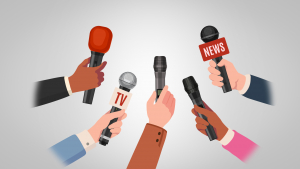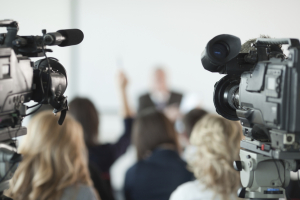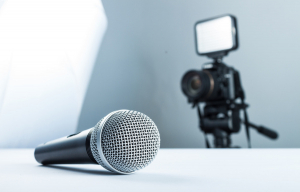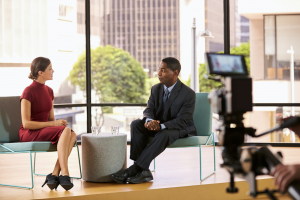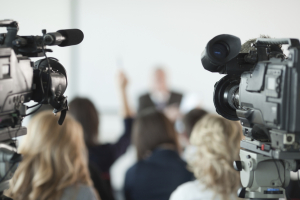-
.
Displaying items by tag: media training course
Use Silence to Speak with Impact - Media Interview Techniques
Why Energy Matters in Media Interviews - Media Training Tips
When it comes to media training, people often focus on what they say. But how you say it is just as important. And that’s where energy comes in.
Energy isn’t about being loud or over the top—it’s about showing that you care. When your voice has life, your eyes are engaged, and you’re actively involved in the conversation, the audience is far more likely to trust and believe you.
TV and radio have a way of flattening everything. So the energy you feel on the inside often doesn’t come across unless you deliberately turn it up a notch. That’s why media training sessions often feel like performance coaching. You need to lift your delivery, bring pace and contrast, and make sure your enthusiasm shines through.
This is especially true if the topic is serious or technical. Energy is what cuts through. It makes people want to listen. And crucially, it makes you feel more confident too.
So next time you’re prepping for an interview, don’t just script your message. Rehearse how you’re going to deliver it—with the energy it deserves.
For more information about our training programmes visit:
https://www.presenterstudio.com/business-presenter-training/media-training
Media Training - Wear Something That Reflects the Tone and Feel of Your Brand
In media appearances, how you look matters – not just in terms of style, but in terms of story. Your clothes send a message. They say something before you’ve even opened your mouth. So what are they saying about your brand?
At The Presenter Studio, one of the first things we ask clients is: Does what you’re wearing reflect the tone and feel of your business? For example, if you’re a relaxed, creative founder, a stiff suit might make you look out of step with your brand identity. Equally, if you’re representing a high-end corporate firm, a casual t-shirt might feel off-brand or unprepared.
Your appearance should support – not contradict – your message. It’s not about fashion. It’s about consistency. Colour, texture, formality, accessories – all these elements help create a visual impression that needs to align with how you want to be perceived.
And it’s not just about the brand. It’s about you, too. You need to feel comfortable and confident. Clothes that feel unfamiliar or awkward will impact how you move, how you sit, how you speak. The best on-camera looks are those that make you feel like the best version of yourself.
In our media training at The Presenter Studio, we offer advice not just on performance, but on styling – what works on camera, what to avoid, and how to find the sweet spot between your brand and your personality. Whether it’s a big studio interview or a social media video, we help you look the part and own the room.
To find out more about how we can prepare you for success in the spotlight, head to: https://www.presenterstudio.com/business-presenter-training/media-training
Media Training - Prepare Your Key Messages and Cut the Waffle
One of the biggest mistakes people make in interviews – whether on TV, radio or online – is trying to say too much. In an effort to be thorough, they waffle. They lose focus. And ultimately, their main point gets lost in a sea of words.
That’s why a cornerstone of great media training at The Presenter Studio is helping clients identify and deliver their key messages. What do you want your audience to remember? What is the one thing you'd say if you only had 20 seconds?
The media doesn’t give you long. A live radio interview might last five minutes, a TV clip might be just 30 seconds. So your job is to edit yourself – to go in prepared with sharp, relevant, and memorable points.
Think of it like packing for a short trip: only take what you absolutely need. The rest is just extra weight. Great communicators don’t ramble – they distil.
To get started, write down three things you want your audience to remember. Then practise saying each one in a single sentence. That’s your foundation. From there, you can add supporting examples, stats or stories if time allows – but you’ve already done the hard part.
Our media training sessions at The Presenter Studio are designed to sharpen your message and help you deliver it with clarity and confidence. We simulate real media environments, offer tailored feedback, and help you learn to stay on track under pressure.
To make your message cut through, visit our media training page and see how we can help: https://www.presenterstudio.com/business-presenter-training/media-training
Media Training - Think of the Camera as a Real Person
Facing a camera can feel unnatural. There's no eye contact, no nodding head, no visible reaction – just a black lens staring back at you. It's no wonder many people freeze, overthink their delivery, or come across as wooden on screen. But here’s one of the most effective – and surprisingly simple – techniques we teach at The Presenter Studio: treat the camera as if it were a real person.
Imagine the camera is your best client, your most engaged colleague, or your most supportive friend. The goal is to create a genuine connection. When you shift your mindset away from ‘broadcasting’ and toward ‘communicating’, your tone naturally becomes warmer, your delivery more relaxed, and your performance more authentic.
Why does this matter? Because viewers can instantly tell when something feels rehearsed or robotic. The magic of great on-camera presence lies in making the audience feel like you’re speaking directly to them, not just delivering a message. Eye-line, tone, and intention all improve when you stop seeing the lens as a threat and start seeing it as a human.
At The Presenter Studio, our clients often find that this one mental shift unlocks a whole new level of confidence. We use practical exercises and personalised coaching to help them come across as natural and connected – even when the red light is on.
If you’d like to feel more at ease on camera and learn techniques used by top broadcasters and business leaders, explore our media training services at: https://www.presenterstudio.com/business-presenter-training/media-training
Best Media Training Course
When it comes to high-pressure media appearances, good intentions aren’t enough. You need training that’s grounded in real-world experience, tailored to your role, and focused on results. Our Best Media Training Course is trusted by CEOs, spokespeople, experts and creatives across the UK and beyond.
We don’t believe in formulaic training. Every course is led by award-winning producers and media experts with a background in national TV and news. You’ll learn how the media really works – from the inside – and how to use interviews to your advantage.
A standout tip from our course: never go into an interview “to inform.” You go in to influence. That means identifying your key messages in advance, preparing memorable soundbites, and bridging from questions to answers with control and authenticity.
We teach a technique called "message sandwiching" – starting with a confident statement, giving a short supporting example, then repeating your key point. It helps you stay on track and gives the journalist exactly what they need – clean, concise quotes.
We also cover crisis communication – how to protect your reputation when the story turns negative. This includes how to stay calm under pressure, avoid being misquoted, and communicate transparency without exposing your organisation to unnecessary risk.
Whether it’s a primetime broadcast, podcast guest spot or internal media piece, our course prepares you to speak with clarity, credibility and composure.
See why so many people call it the best training they’ve ever had: https://www.presenterstudio.com/business-presenter-training/media-training
Media Training Course Online
In today’s digital-first world, media opportunities can arise fast – and they don’t always happen face-to-face. Whether you’re asked to join a live podcast, a Zoom interview, or a broadcast via Teams, the ability to present yourself well on camera is vital. Our Media Training Course Online is designed to help professionals deliver clear, confident and compelling media performances from anywhere in the world.
This virtual course mirrors our in-person coaching, with one major difference: we train you in the exact environment you’ll appear in. That means practising on Zoom, learning where to look on screen, managing your setup, lighting and background, and mastering eye-line for maximum impact.
A common mistake people make online is staring at themselves on the screen, rather than the camera. We help you reposition your gaze, so you appear confident, present and trustworthy. We also teach how to manage nerves and think on your feet – essential for handling tough questions or unexpected turns.
Our online media training covers everything from messaging and key soundbites to body language, voice control and crisis comms. The format is flexible – we offer one-to-one sessions or group training depending on your needs.
Clients often say this course transforms not just how they perform on screen, but how they feel. With the right training, even the most camera-shy professionals can develop a warm, authentic and authoritative media presence – all without leaving home.
Get started here: https://www.presenterstudio.com/business-presenter-training/media-training
What Is Media Training and Why Do You Need It?
Media training is about learning how to communicate well in the spotlight. It’s not just for celebrities or politicians. In fact, it’s increasingly important for business leaders, brand spokespeople, and anyone who might need to represent their company in the media.
At its heart, media training is about helping you speak with clarity, confidence, and control. That could be during a TV appearance, a radio interview, a podcast, or even a live social media stream. It helps you understand what journalists want, how to frame your message, and how to stay composed under pressure.
A good media trainer will help you prepare for different types of questions — from the friendly to the challenging. You’ll learn how to keep answers concise, how to land key points, and how to avoid common pitfalls that can derail your message.
It’s not about learning a script. It’s about knowing how to speak in your own voice, while staying on message. The best media appearances are the ones that feel authentic. And that takes practice.
If you're representing your brand or business in public, media training can give you the tools to do it with impact and authority. At Presenter Studio, we’ve coached CEOs, founders, and on-screen talent to build confidence and stay in control. Explore how our media training can support you here: https://www.presenterstudio.com/business-presenter-training/media-training
Media Training – Our Top 3 Tips for Success on Camera
Whether you're preparing for a TV interview, a press day, or an online video, one of the biggest challenges is how to come across naturally on camera. It can feel unfamiliar. Formal. Sometimes even intimidating. But with a few simple shifts, you can take control and deliver your message with warmth, clarity, and confidence.
The first tip is to treat the camera as a friend. Instead of seeing it as a lifeless machine or a judging eye, imagine you're speaking to someone you know. Someone you like. This instantly softens your body language and helps your voice feel more conversational. The audience may be behind the lens, but if you speak as if they’re right in front of you, they’ll feel more connected to what you’re saying.
Second, look to deformalise the space. Traditional settings can sometimes make us stiff. Whether it's a corporate boardroom or a sterile studio, try to bring a sense of ease into the environment. This might be through how you sit, how you breathe, or simply the tone you use. Speak as if you’re having a conversation rather than delivering a speech. You’re not reciting lines — you’re sharing a message.
And finally, know your message, not your script. Trying to memorise word for word can trip you up and make you sound robotic. Instead, get clear on the points you want to make. If you know your message inside out, you’ll be able to adapt in the moment and sound more human.
At Presenter Studio, we’ve worked with some of the UK’s top talent to help them shine in interviews and on screen. Our media training is all about helping you find your natural voice and build trust with your audience. Discover more about the course at https://www.presenterstudio.com/business-presenter-training/media-training
The Top Benefits of Media Training for Business Leaders
Strong communication is a hallmark of great leadership. Whether you're managing a team or speaking on behalf of a company, the way you deliver your message can influence perception, trust and engagement. Media training equips business leaders with the tools to communicate with clarity, confidence and authority.
One of the biggest advantages of media training is how it boosts self-assurance. Leaders often know what they want to say, but under pressure, it can be easy to lose focus or sound unsure. Training helps you stay composed, make your points effectively and manage difficult questions.
Another benefit is that it helps you sound like you, but your best version. Media training isn’t about rehearsed lines. It’s about finding your voice, knowing your message and delivering it in a way that feels natural.
Business leaders are often asked to speak at events, do interviews, or appear in internal communications. Being unprepared can lead to missed opportunities. Media training is not just about interviews with journalists. It's about making sure you come across well in all your communications.
If you're a senior professional looking to develop your communication skills, explore how our tailored sessions can help: https://www.presenterstudio.com/business-presenter-training/media-training


